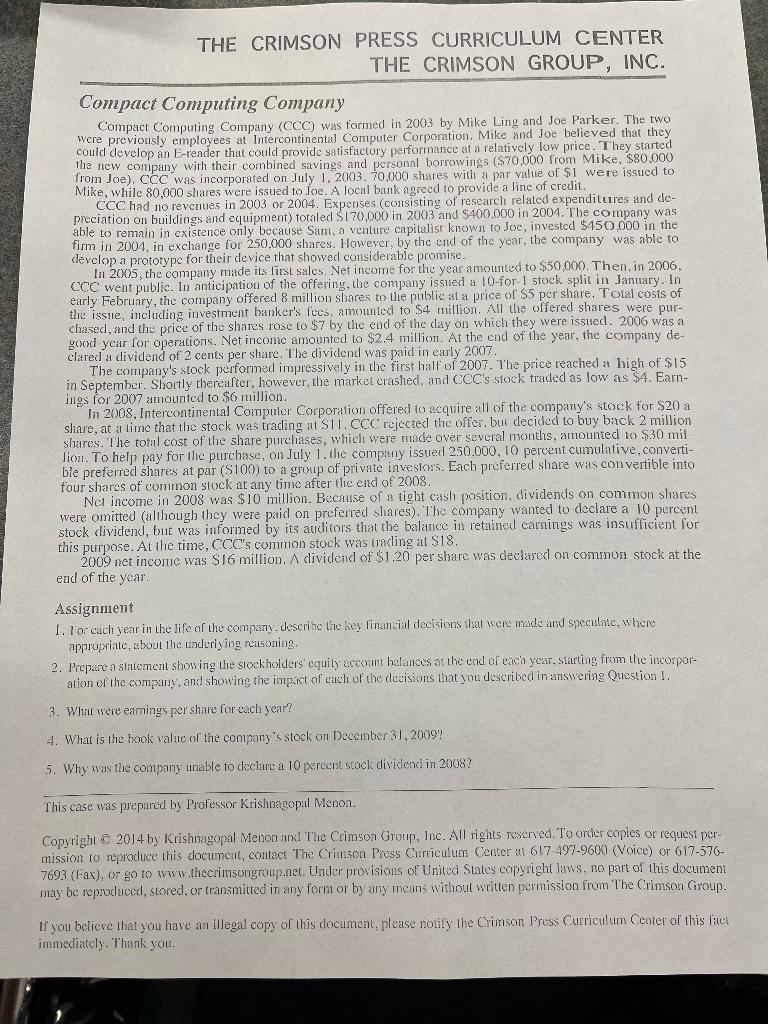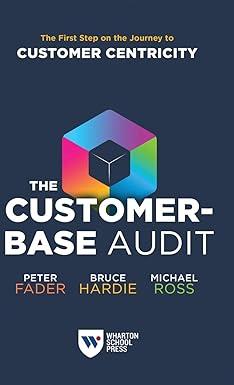
THE CRIMSON GROUP, INC. Compact Computing Company Compact Computing Company (CCC) was formed in 2003 by Mike Ling and Joe Parker. The two were previously employees at Intercontinental Computer Corporation. Mike and Joe believed that they could develop an E-reader that could provide satisfactory performance at a relatively low price. They started the new company with their combined savings and personal borrowings ( $70,000 from Mike, $80,000 from Joe), CCC was incorporated on July 1, 2003. 70,000 shares with a par value of $1 were issued to Mike, while 80,000 shares were issued to Joe. A local bank agreed to provide a line of credit. CCC had no revenues in 2003 or 2004 . Expenses (consisting of research related expenditures and depreciation on buildings and equipment) toraled $170,000 in 2003 and $400,000 in 2004. The company was able to remain in existence only because Sam, a venture capitalist known to Joe, invested $450.000 in the firm in 2004, in exchange for 250,000 shares. However, by the end of the year, the company was able to develop a prototype for their device that showed considerable promise. In 2005, the company made its first sales. Net income for the year amounted to $50,000. Then, in 2006 CCC went public. In anticipation of the offering, the company issied a 10 -for-1 stock split in January. In early February, the company offered 8 million shates to the public at a price of $5 per share. Total costs of the issue, including investment banker's fees. amounted to $4 million. All the offered shares were purchased, and the price of the shares rose to $7 by the end of the day on which they were issued. 2006 was a good year for operations. Net income amounted to $2.4 million. At the end of the year, the company declared a dividend of 2 cents per share. The dividend was paid in early 2007 The company's stock performed impressively in the first half of 2007 . The price reached a high of \$15 in September. Shotty thereafter, however, the market crashed, and CCC's stock traded as low as $4. Earnings for 2007 anrounted to $6 million. In 2008, Intercontinental Compuler Corporation offered to acquire all of the company's stock for $20 a share, at a lime that the stock was trading at S11. CCC rejected the offer, but decided to buy back 2 million shares. The total cost of the share purchases, which were made over several months, amounted to $30mil lion. To help pay for the purchase, on July 1 , fie company issued 250.000,10 percent cumulative, convertible preferred shares at par (S100) to a group of private investors. Each preferred share was convertible into four shares of common stock at any time after the end of 2008 . Net income in 2008 was $10 million. Because of a tight cash position, dividends on common shares were omitted (although they were paid on preferted shares). The company wanted to declare a 10 percem stock dividend, but was informed by its auditors that the balance in retaned earnings was insufficient for this purpose. At the time, CCC's common stock was uading at $18. 2009 net income was $16 million. A dividend of $1,20 per share was declared on common stock at the end of the year: Assignment 1. For cach year in the life of the company, describe the aey linancial decisions shal were made and speculate, where appropriate, about the underiying reasoning. 2. Prepane a slatement showing the slockholders equily accoin balances at the end of each year, starting from the incorporation of the company, and showing the impact of emch of the decissons that you deseribed in answering Question 1. 3. What weie eamings per share for each year? 4. What is the hook ralue of the company's stock on December 31, 2009? 5. Why was the company unable to declarc a 10 percent stack dividend in 2008 ? This case was prepared by Professor Krishoagopal Menon. Copyright \& 2014 by Krishnagopal Menon and The Crimson (jroup, Inc. All rights reserved. To order copies or reguest permission to reproduce this document, contact The (rimson Pross (urriculum Center at 617 497-9600 (Voice) or 617 -5767693 (Fax), or go to www thecrimsongroup.net. Under provisions of United States capyright laws, no part of this document may be reproduced, stored, or transmitted in any form or by any means withoul writen permission from The Crimson Croup. II you believe that you have an illegal copy of this document, please notify the Crimson Press Curriculum Center of this lack immediately. Thank yous







